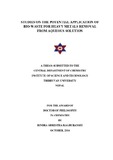Please use this identifier to cite or link to this item:
http://archive.nnl.gov.np:8080/handle/123456789/378| Title: | STUDIES ON THE POTENTIAL APPLICATION OF BIO-WASTE FOR HEAVY METALS REMOVAL FROM AQUEOUS SOLUTION |
| Authors: | SHRESTHA RAGHUBANSHI, BINDRA |
| Keywords: | adsorption, biosorbents, heavy metals, Langmuir isotherm, pseudo- second order model |
| Issue Date: | 27-Mar-2019 |
| Abstract: | An efficient and effective biosorbents were investigated by using waste tealeaves. It was prepared by amination with three different aminating reagents to introduce amino groups onto the surface of biosorbent. The biosorbent was aminated by using ethylenediamine, dimethylamine and hydrazine monohydrate. They are called CATL-1, CATL-2 and CATL-3, respectively. The prepared biosorbents were characterized with elemental analysis, analysis of cellulose, hemicelluloses and lignin, SEM images, FTIR spectra, XRD analysis, TG/DTA analysis and zeta potential analysis. These aminated biosorbents were used for sequestration of heavy metals like lead, copper, cadmium and zinc. Their metal uptake perfomance were also elucidated by using batch experiments. The adsorption capacities of biosorbents were studied as the function of solution pH, initial concentration of metal ions and contact time of adsorption. The effect of pH on adsorption were studied by varying the solution pH from 1-7. The results indicated that the uptake performance of biosorbents significantly change with pH of solution and optimum pH for adsorption was also determined. The initial concentration of metal ions varying from 25-800 mg/L were used to calculate the optimum loading capacity of biosorbents. The optimum time for adsorption were determined by contacting the adsorbent with metal solution at different interval of time. The experimental data were found to be well fitted with langmuir isotherm model. From the isotherm plots the maximum adsorption capacities for lead was found to be highest for all of the three adsorbents while the values were lowest for zinc. Among the three biosorbents, CATL-3 is found to be having highest adsorption capacity for all metal ions used in this study. In CATL-3, the maximum adsorption capacity for Pb (II), Cu (II), Cd (II) and Zn (II) are found to be 120.8, 90.4,114.3 and 79.76 mg/g, respectively. The optimum contact time for metal ions are found to be between 120 - 150 min for all the biosorbents. The kinetic data were well fitted with pseudo - second order model. Hence the biosorbents prepared from waste tealeaves can be potentially applied for treatment of waste water contaminted with toxic heavy metals. |
| URI: | http://103.69.125.248:8080/xmlui/handle/123456789/378 |
| Appears in Collections: | 500 Natural sciences and mathematics |
Files in This Item:
| File | Description | Size | Format | |
|---|---|---|---|---|
| Brindra Shrestha Thesis.pdf | 11.54 MB | Adobe PDF |  View/Open |
Items in DSpace are protected by copyright, with all rights reserved, unless otherwise indicated.